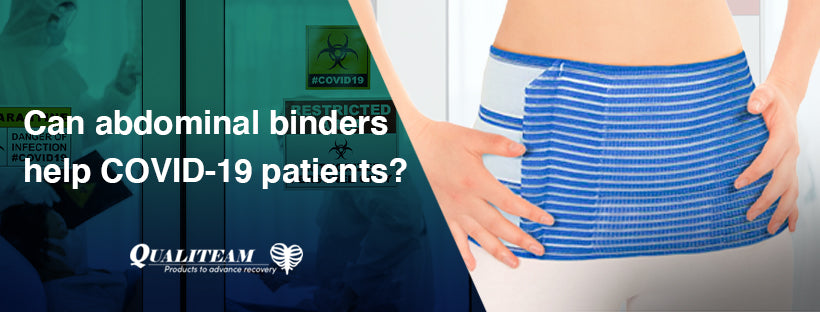There have recently been several reports in the news [1-3] that placing ventilated COVID-19 patients in the prone position about 16 hours per day helps significantly to increase the oxygen saturation of the lungs. The explanation seems to be that sections of the lungs are being squeezed by the weight of the body when patients are on their back. Turning them on their bellies opens up these parts of the lungs for better oxygenation.
The idea of using the prone position in COVID-19 patients can be related to numerous studies [4-8] proving the benefits for patients with chronic obstructive pulmonary disease (COPD), and acute respiratory distress syndrome (ARDS), - conditions with similarities to the decreased lung function in COVID-19 patients.
However, there are disadvantages to having patients in the prone position: There could be increased risk of air-born contamination when turning ventilated COVID-19 patients in the prone position, and they require more sedation which may prolong the ICU stay. Non-ventilated and non-sedated COVID-19 patients may find it uncomfortable to be on their stomachs for 16 hours so they don’t achieve a significant increase in oxygenation.
Could the answer be the use of abdominal binders?
Scientific publications have shown that breathing efficiency increases in patients with COPD when they use an abdominal binder. The positive effect on breathing when applying an abdominal binder is also documented in patients with spinal cord injuries [9-12]. If the impact on lung function in COVID-19 patients has similarities to COPD patients, it gives reason to speculate if an abdominal binder could help.
How can an abdominal binder improve breathing? The explanation is related to that intra-abdominal pressure is needed to expand the ribcage and thereby the lungs, which is why the diaphragm is an important muscle for breathing [13,14]. The diaphragm is a large dome-shaped muscle that separates the thoracic and abdominal cavities. It has a central tendon, and peripheral muscular fibers that are attached to the lower border of the rib cage - an area called the zone of apposition. During inspiration these muscle fibers contract which both flattens the diaphragm (moves it downwards) and expands the ribcage in an outwards direction. This action enlarges the pleural cavity and the lungs (breathing air in) and increases pressure in the abdominal cavity moving the abdominal wall outwards. If the abdominal wall is prevented from moving outwards, like when an abdominal binder is used, the expansion of the lower ribcage increases further, since the diaphragm with the contracting peripheral muscles attached to the ribcage is forced higher, thus improving lung expansion.
If abdominal binders can help COPD patients and if COVID-19 patients have lung conditions that are similar to COPD, can it be assumed that a similar positive effect on breathing could be achieved by applying abdominal binders to COVID-19 patients? And could it be a viable way to help to decrease a 16-hour prone position?
References:
- https://edition.cnn.com/2020/04/14/health/coronavirus-prone-positioning/index.html
- https://www.youtube.com/watch?v=ECdxhNFLwVo
- https://www.healio.com/pulmonology/critical-care/news/online/%7B8fb470fd-092a-4e58-bdfc-95c1dc12b1e0%7D/body-positioning-may-affect-lung-recruitability-in-covid-19-related-ards
- Kallet R.H. A Comprehensive Review of Prone Position in ARDS. Respiratory Care. November 2015 Vol. 60 No. 11. DOI: 10.4187/respcare.04271
- Guèrin C. et al. Prone Positioning in Severe Acute Respiratory Distress Syndrome. N Engl J Med 2013;368:2159-68. DOI: 10.1056/NEJMoa1214103
- Reignier J et al. Short-term effects of prone position in chronic obstructive pulmonary disease patients with severe acute hypoxemic and hypercapnic respiratory failure. Intensive Care Med. 2005 Aug;31(8):1128-31 DOI: 10.1007/s00134-005-2658-5
- Mentzelopoulos SD et al. Prone position improves lung mechanical behavior and enhances gas exchange efficiency in mechanically ventilated chronic obstructive pulmonary disease patients. Anesth Analg. 2003 Jun;96(6):1756-67 DOI: 10.1213/01.ane.0000064282.79068.1e
- Gattinoni l. et al. Effect of Prone Positioning on the Survival of Patients with Acute Respiratory Failure. N Engl J Med 2001; 345:568-573 DOI: 10.1056/NEJMoa010043
- Wadsworth BM et al. Abdominal Binder Improves Lung Volumes and Voice in People With Tetraplegic Spinal Cord Injury. Arch Phys Med Rehabil Vol 93, December 2012. doi.org/10.1016/j.apmr.2012.06.010
- Kachpile ST et al. Immediate effect of abdominal binder on peak expiratory flow rate (PEFR) in chronic obstructive pulmonary disease (COPD) patients. Int. J. of Allied Med. Sci. and Clin. Research Vol-6(1) 2018 [114-117]
- Dodd DS et al. Effect of abdominal strapping on chest wall mechanics during exercise in patients with severe chronic air-flow obstruction. Am Rev Respir Dis. 1985 Jun;131(6):816-21 DOI: 10.1164/arrd.1985.131.6.816
- Abdallah et al. Abdominal Binding Improves Neuromuscular Efficiency of the Human Diaphragm during Exercise. Front. Physiol. 8:345. doi: 10.3389/fphys.2017.00345
- Gartman EJ et al. Dependence of Diaphragm Function on Abdominal Compliance. Ann Am Thorac Soc Vol 16, No 3, pp 381–386, Mar 2019. DOI: 10.1513/AnnalsATS.201809-616CC
- De Troyer A et al. Action of the diaphragm on the rib cage. J Appl Physiol 121: 391–400, 2016 doi:10.1152/japplphysiol.00268.2016


1 comment
Jul 21, 2021 • Posted by Cristina Amuchastegui
Good morning, I am Cristina Amuchastegui, Lic, in Kinesiology and Physiotherapy. I work in a Covid-19 reference hospital in Tucumán, Argentina, a red zone of poverty.
During 2020 I began to research the use of protective girdles in patients with Covid-19. Since most patients are low-income, I used scarves, towels or sheets as girdles to increase blood oxygen saturation and decrease the respiratory rate to improve ventilatory mechanics. I began to ask those patients who could afford it to buy girdles and we used them with even more effective results, perhaps obtaining an earlier discharge from the hospital than in patients who did not use girdles.
All this I wanted to tell you because by chance I read your article on the use of girdles in Covid-19 patients, and I can assure you that it totally works.
I saw that you are willing to donate girdles, but understand that we are very far away and I do not know if there will be that possibility. Thank you very much for reading my mail, I am at your disposal.
Greetings Cristina Amuchastegui, Tucumán, Argentina.
Leave a comment: